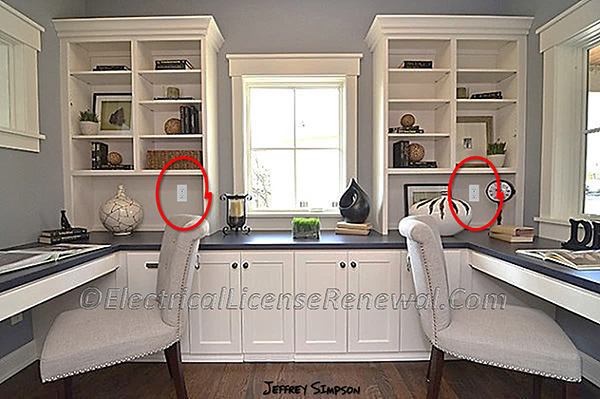210.52(A)(2) Dwelling Unit Receptacle Outlets. Wall Space.

Code Change Summary: Additional code language clarifies how to measure “wall space” for receptacle placement when fixed cabinets are installed.
Section 210.52(A)(2) explains what is considered “wall space”. This is important when applying 210.52(A)(1) and determining where receptacles are needed in a dwelling.
When the phrase “fixed cabinets” was first introduced to 210.52(A)(2)(1) two code cycles ago, it created confusion. The idea is to have no point measured horizontally along the floor line of any “wall space” that is more than 6 ft. from a receptacle outlet. When measuring “wall space”, a doorway, fireplace, fixed cabinet or similar opening can break up the measurement and the space behind them does not contribute to the measurement. As well, receptacles are not required in the area occupied by these items unless required elsewhere in the NEC®, such as kitchen countertops covered in 210.52(C).
The problem with allowing any “fixed cabinet” to break up the wall space measurement is that the same rule would apply to any area of a house where fixed cabinets are installed, not just the kitchen. Sometimes people use kitchen style cabinets with countertops in other areas of a home besides the kitchen. It’s quite common to turn an unused bedroom into a home office by adding kitchen style or built-in cabinets with countertops along one or more walls. Technically, in this case, the 2014 NEC® would not require a single receptacle in the wall behind the fixed cabinets.
The 2017 NEC® has cleared that up. Now, only a fixed cabinet without a countertop or similar work surface can break up the wall space measurement. If a fixed cabinet has a countertop then it is included in the wall space measurement.
This is a very tough code section to read, because of the double negatives used in the code language, and just as hard to explain. The struggle is with the idea that a wall space can’t be broken by something that is without something.
According to the revised code language, when measuring wall spaces to determine if they need a receptacle, a wall space includes any space 2 foot wide or more, that is unbroken along the floor line by doorways and similar openings, fireplaces, and fixed cabinets without a countertop or similar work surface.
For it to be a wall space, it can’t be broken by a fixed cabinet having no counter. So, in reverse, it can be broken by a fixed cabinet having a countertop and still be considered wall space.
If the cabinet has no counter, then it is likely a floor to ceiling cabinet where a receptacle can’t even be placed. If the cabinet has a countertop then it is likely that a receptacle can be placed just above the counter and be useful to someone.
In other words, for it to qualify as a wall space and need a receptacle, a 2-foot wall space can’t be broken by a fixed cabinet having no countertop. If the same space is broken by a fixed cabinet with a countertop then it is still considered wall space.
Below is a preview of Article 210. See the actual NEC® text at NFPA.ORG for the complete code section. Once there, click on their link to free access to the 2017 NEC® edition of NFPA 70.
2014 Code Language:
210.52(A)(2) Wall Space. As used in this section, a wall space shall include the following:
(1) Any space 600 mm (2 ft) or more in width (including space measured around corners) and unbroken along the floor line by doorways and similar openings, fireplaces, and fixed cabinets
(2) The space occupied by fixed panels in exterior walls, excluding sliding panels
(3) The space afforded by fixed room dividers, such as freestanding bar-type counters or railings
2017 Code Language:
210.52(A)(2) Wall Space. As used in this section, a wall space shall include the following:
(1) Any space 600 mm (2 ft) or more in width (including space measured around corners) and unbroken along the floor line by doorways and similar openings, fireplaces, and fixed cabinets that do not have countertops or similar work surfaces
(2) The space occupied by fixed panels in walls, excluding sliding panels
(3) The space afforded by fixed room dividers, such as freestanding bar-type counters or railings